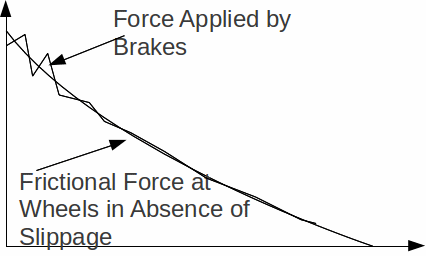Brakes operate by creating as much friction as possible. The friction is created between the brake shoes and the wheel. When the brake shoes come into contact with the wheel, the wheel is foirced to turn more slowly until it stops.
There is a problem however. There is also friction between the tyre and the road. When the wheel starts to turn, this friction between the tyre and the road means the wheels do not slip and the car moves. This friction between the tyres and the wheel cannot have more than a maximum value. If the car accelerates or decelerates too fast, then the friction force between the tyres and the road is insufficient to prevent the tyres slipping. When slipping occurs friction decreases suddenly, and it is necessary to slow the rate at which the wheels turn or even stop the wheels turning so that the tyres will grip the road. Slipping is especially undesirable when braking, when it is sometimes necessary to stop in the least possible distance. If slipping occurs, friction between the tyres and the road is reduced and the car takes longer to stop. The driver's instincts are to apply the brakes as hard as possible, but this only tends to increase the amount of slipping.
To overcome this, some vehicles are fitted with anti lock brakes. When slipping is detected, computers reduce the braking force so that the wheels are allowed to turn and grip the road. As soon as this grip is re – established, computers increase the braking force again. This process can happen hundreds of times a second. In this way, the frictional force is always maximised so that the car is brought to rest in the least possible distance.

